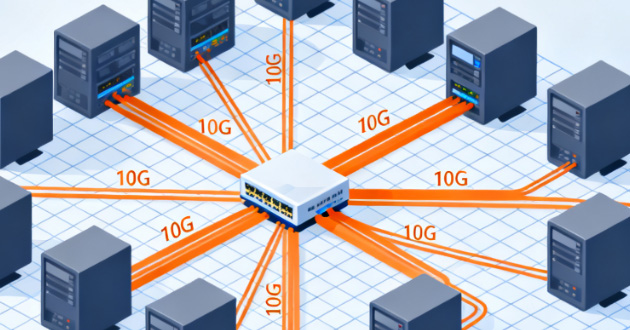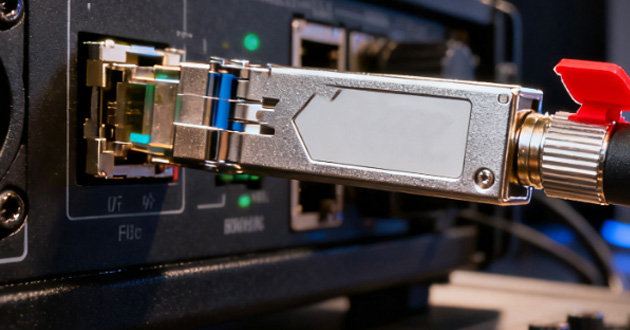In this article, we’ll break down what SFP stands for and how it works, explore the key features and functions that make SFP modules so widely adopted, and look at the most common SFP types and where they fit in real-world deployments. Whether you’re maintaining legacy Gigabit networks, building a new data center fabric, or planning a gradual migration from copper to fiber, understanding SFP modules will help you design networks that are more flexible, scalable, and future-ready.
SFP stands for Small Form-factor Pluggable. An SFP module is a compact, standardized plug-in unit that fits into network devices such as switches, routers, servers, and firewalls. Instead of locking each device into a single built-in port type, vendors provide an SFP port and let you decide how that port will be used—fiber or copper, short-reach or long-distance. In other words, many of the physical-layer choices move out of the chassis and into the SFP module itself, which is especially helpful in environments where link speed, distance, and cabling can vary from rack to rack or site to site.

Functionally, an SFP module is a two-way transceiver: it sends and receives data using the same compact form factor. On the host side, the SFP module connects to high-speed electrical interfaces driven by the switch or router’s ASIC. On the network side, it converts those signals into optical outputs over fiber or electrical outputs over copper, depending on the specific SFP module you install. In this role, the SFP module acts as a translation layer between the device’s internal silicon and the external cabling, bridging the logic inside the box with the physical layer in the field. Because SFP modules are hot-swappable, they can be changed while the equipment remains powered on, making it possible to adjust speed, medium, or link distance without scheduling downtime.
In everyday use, this flexibility means a single SFP-capable switch can play many roles simply by changing the mix of SFP modules. One SFP port might use a short-reach multimode module for connections within a wiring closet, another might use a single-mode module for building-to-building or campus links, while a third might be equipped with an RJ45 SFP module for copper runs inside a rack. This modular design lets network engineers tune each port to its specific job, scaling and adapting connectivity as requirements evolve—without being tied to a single, fixed interface type at the hardware level.

Connectivity
An SFP module immediately broadens the connectivity options of a network device by making the physical interface modular rather than fixed. A single SFP slot can take modules for multimode or single-mode fiber, as well as copper-based RJ45 SFP modules, so the same switch or router can fit very different deployment environments. Whether you need a short copper hop inside a rack, a fiber run across a campus, or a long-distance single-mode link between sites, the SFP module—rather than the chassis—defines the medium. This makes SFP-equipped platforms much easier to align with real-world cabling constraints and future changes.

Hot-swappable Operation
SFP modules can be inserted or removed without shutting down the host device, which brings clear operational benefits. The network can stay online while a technician replaces a failed optic, upgrades a link to a higher speed, or switches from copper to fiber simply by swapping modules. This hot-swap capability reduces disruption, cuts the need for planned outages, and lightens the workload for teams running high-availability networks. In environments where continuous service is critical—such as data centers, telecom nodes, and industrial systems—this behavior makes SFP-based designs noticeably more robust.
Versatility Across Speeds and Distances
The SFP module ecosystem includes options tuned for almost any combination of speed, distance, and optical budget. Short-reach multimode modules cover local and equipment-room links; single-mode variants extend connectivity across buildings, campuses, or metro networks; copper SFP modules offer cost-effective Ethernet over twisted pair; and CWDM/DWDM SFP modules enable wavelength-multiplexed transport over existing long-haul fiber. With this range of choices, designers can match each link to its workload and constraints simply by picking the appropriate module—no changes to the underlying hardware required.

Compact Size & High Port Density
The small footprint of SFP modules allows manufacturers to fit far more interfaces on a single switch or router than older form factors like GBIC ever could. Higher port density translates into more bandwidth per rack unit, better use of space, and more efficient power and cooling in tightly constrained facilities. This compact design is a major reason why SFP modules—together with higher-speed variants such as SFP+ and SFP28—have become the standard for modern aggregation and data center switching, where density and scalability are key design goals.
Common Types of SFP Modules and Their Use Cases
|
Type |
Typical Speed |
Medium |
Typical Use Case |
|
SFP (1G SFP) |
Up to 1.25 Gbps |
Fiber or copper |
Standard Gigabit Ethernet, access switches, edge links |
|
SFP+ |
Up to 10 Gbps |
Mainly fiber, some DAC/copper |
Data centers, aggregation switches, server uplinks |
|
Single-mode fiber SFP |
1G / 10G (varies) |
Single-mode fiber |
Long-distance links between buildings or sites |
|
Multimode fiber SFP |
1G / 10G (varies) |
Multimode fiber |
Short to medium links within rooms, floors, campuses |
|
Copper SFP (RJ45 SFP) |
1G / 10G (limited) |
Copper (twisted pair Ethernet) |
Short-reach, low-cost connections within racks/closets |
A 1G SFP module is the entry-level option in the SFP family, operating at around 1.25 Gbps for standard Gigabit Ethernet. Its value today is less about peak speed and more about broad compatibility, maturity, and low cost. A large number of access switches, industrial devices, and legacy platforms still rely on 1G links, and 1G SFP modules remain the most straightforward way to extend or modernize these networks without replacing existing hardware. Their modest power consumption and attractive pricing make them a solid fit for management ports, user access, and out-of-band connections where 10G bandwidth isn’t necessary.

SFP+ modules share the same compact footprint as SFP, but are designed for 10 GbE and other high-speed services. They’re not just “faster”—they’re often used as a consolidation point, where a single 10G SFP+ uplink can take the place of several 1G links, simplifying cabling and reducing oversubscription. This makes SFP+ particularly well suited to virtualization clusters, dense server racks, storage networks, and leaf–spine fabrics, where east–west traffic can be intense. For short distances, SFP+ DAC cables provide a neat, low-latency solution by integrating the transceiver and cable into a single passive or active assembly.
Single-mode SFP modules are built for long-distance, high-quality links. They’re commonly deployed for connections across campuses, between buildings, or into metro and carrier networks. Their strength isn’t only the distance they can cover, but the signal integrity they maintain over those distances: single-mode optics handle attenuation, splices, and outdoor segments more gracefully than many alternatives. Once single-mode fiber is installed, these SFP modules give operators a robust optical backbone that can be upgraded to higher speeds later simply by changing the optics, not the fiber.

Multimode SFP modules are optimized for shorter runs and high-density environments. They’re a natural fit for structured cabling inside offices, data centers, and campus cores, where fiber links are frequent but relatively short. At these distances, multimode optics are typically more economical and integrate smoothly with existing OM2/OM3/OM4/OM5 cabling. As a result, they’re widely used for switch-to-switch connections, aggregation links, and phased upgrades where installing new single-mode fiber would be too expensive or disruptive.
Copper SFP modules, often referred to as RJ45 SFPs, provide a flexible alternative to fixed copper Ethernet ports. Instead of dedicating part of the front panel to permanent RJ45 interfaces, you can selectively populate SFP slots with copper modules where needed and reserve the rest for fiber. This is especially useful at the network edge, where many servers and end devices still rely on copper NICs. Copper SFPs are also valuable during migration phases: they support a gradual transition from copper-heavy designs to fiber-centric architectures without forcing a one-time, large-scale change. For short, local links where fiber brings little advantage, an RJ45 SFP is often the simplest and most economical choice.

https://www.glgnet.biz/articledetail/what-is-sfp-port.html
https://www.glgnet.biz/articledetail/what-is-the-data-rate-of-qsfp-dd.html
Conclusion
SFP modules may be small in size, but they sit at a critical intersection between switching silicon and the physical cabling plant. By making ports modular, hot-swappable, and media-agnostic, SFP technology turns each interface into a configurable resource rather than a fixed constraint. From 1G SFP for cost-effective access, to SFP+ for 10G aggregation, to single-mode, multimode, and copper variants tailored to different distances and environments, the SFP ecosystem covers an impressive range of use cases.